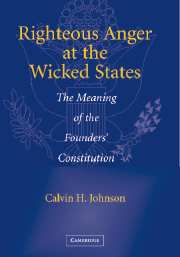Book contents
- Frontmatter
- Contents
- Acknowledgments
- Frequently Cited Sources
- Introduction
- PART ONE THE NECESSITY OF THE CONSTITUTION
- 1 The Rise of the Righteous Anger
- 2 Madison's Vision: Requisitions and Rights
- 3 The Superiority of the Extended Republic
- 4 Shifting the Foundations from the States to the People
- 5 Partial Losses
- 6 Anti-Federalism
- 7 False Issues: Bill of Rights, Democracy, and Slavery
- PART TWO LESS CONVINCING FACTORS
- PART III THE SPLIT AND THE END OF THE CONSTITUTIONAL MOVEMENT
- Concluding Summary
- Index
2 - Madison's Vision: Requisitions and Rights
Published online by Cambridge University Press: 27 July 2009
- Frontmatter
- Contents
- Acknowledgments
- Frequently Cited Sources
- Introduction
- PART ONE THE NECESSITY OF THE CONSTITUTION
- 1 The Rise of the Righteous Anger
- 2 Madison's Vision: Requisitions and Rights
- 3 The Superiority of the Extended Republic
- 4 Shifting the Foundations from the States to the People
- 5 Partial Losses
- 6 Anti-Federalism
- 7 False Issues: Bill of Rights, Democracy, and Slavery
- PART TWO LESS CONVINCING FACTORS
- PART III THE SPLIT AND THE END OF THE CONSTITUTIONAL MOVEMENT
- Concluding Summary
- Index
Summary
At the start of the Constitutional Convention in Philadelphia in May 1787, the Virginia delegation offered a plan, now called the Virginia Plan, which set the agenda for the deliberations. The Virginia Plan proposed a strong national government, “breathtaking,” Gordon Wood has called it, in its contrast to the weak assembly of delegates from the states that preceded it. Under the Virginia Plan, the government at the national level would be a complete government, able to raise taxes act on its own without approval of the states. National law would be supreme over state law. To Lord Dorchester, governor of Quebec, the Virginia Plan is the Constitution: When the Convention had finished, Lord Dorchester reported home that the delegates rejected the New Jersey Plan, which would have merely increased the powers of the present congress, on the ground that the powers it gave to the congress were insufficient. They had rejected Alexander Hamilton's plan, which, Dorchester claimed, would have established a monarchy. The Convention, he said, had adopted the Virginia Plan.
Edmund Randolph, then governor of Virginia, offered the Virginia Plan to the Convention, but it had been largely written by James Madison. Madison had to give up some provisions of his nationalism in the Virginia Plan. As the Convention continued, Madison lost on issues that were important to him.
- Type
- Chapter
- Information
- Righteous Anger at the Wicked StatesThe Meaning of the Founders' Constitution, pp. 40 - 60Publisher: Cambridge University PressPrint publication year: 2005



